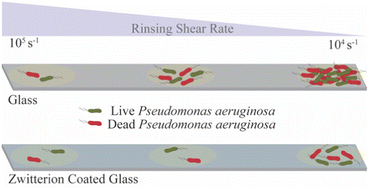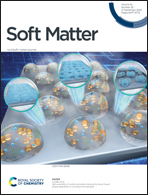Zwitterionic surface chemistry enhances detachment of bacteria under shear†
Abstract
The ubiquitous nature of microorganisms, especially of biofilm-forming bacteria, makes biofouling a prevalent challenge in many settings, including medical and industrial environments immersed in liquid and subjected to shear forces. Recent studies have shown that zwitterionic groups are effective in suppressing bacteria and protein adhesion as well as biofilm growth. However, the effect of zwitterionic groups on the removal of surface-bound bacteria has not been extensively studied. Here we present a microfluidic approach to evaluate the effectiveness in facilitating bacteria detachment by shear of an antifouling surface treatment using (3-(dimethyl;(3-trimethoxysilyl)propyl)ammonia propane-1-sulfonate), a sulfobetaine silane (SBS). Control studies show that SBS-functionalized surfaces greatly increase protein (bovine serum albumin) removal upon rinsing. On the same surfaces, enhanced bacteria (Pseudomonas aeruginosa) removal is observed under shear. To quantify this enhancement a microfluidic shear device is employed to investigate how SBS-functionalized surfaces promote bacteria detachment under shear. By using a microfluidic channel with five shear zones, we compare the removal of bacteria from zwitterionic and glass surfaces under different shear rates. At times of 15 min, 30 min, and 60 min, bacteria adhesion on SBS-functionalized surfaces is reduced relative to the control surface (glass) under quiescent conditions. However, surface-associated bacteria on the SBS-functionalized glass and control show similar percentages of live cells, suggesting minimal intrinsic biocidal effect from the SBS-functionalized surface. Notably, when exposed to shear rates ranging from 104 to 105 s−1, significantly fewer bacteria remain on the SBS-functionalized surfaces. These results demonstrate the potential of zwitterionic sulfobetaine as effective antifouling coatings that facilitate the removal of bacteria under shear.

- This article is part of the themed collection: Soft Matter Editorial Board Highlights of 2022


 Please wait while we load your content...
Please wait while we load your content...
